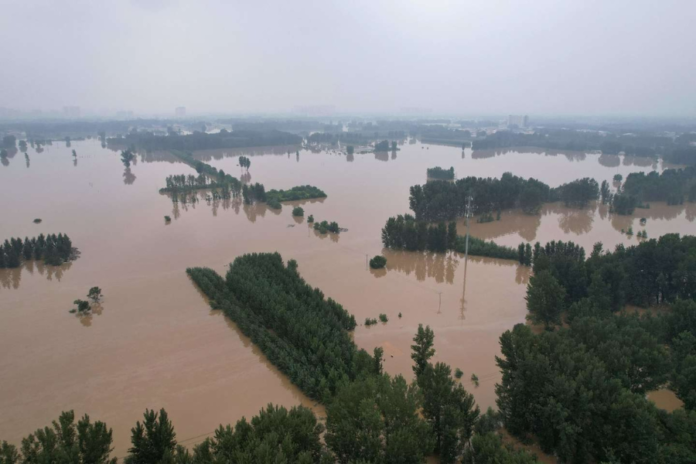Last week, Typhoon Doksuri’s aftermath caused unprecedented flooding throughout northern China, prompting the province government to direct water from overflowing reservoirs towards populated regions in order to shield Beijing from the worst consequences.
In the past, floodwaters were directed into sparsely populated low-lying plains close to the capital, but in 2017, the area became the site of the Xiong’an New Area development—a pet project of Chinese President Xi Jinping intended to serve as a second bureaucratic capital. This move sparked widespread outrage.
Although the exact number of deaths from the flooding is still unknown, dozens of people perished, and 1.5 million people were forced to leave their homes, largely in the province of Hebei, including nearly 1 million people who lived in the so-called flood control zones where the water was diverted. Although it is wise to be sceptical of such promises, the central government has pledged that homes devastated by the floods will be repaired by winter. From drowned sheep to demolished warehouses, the floods appear to have caused enormous economic harm.
Hebei’s CCP secretary, Ni Yuefeng, stated on WeChat last Thursday that the region would “resolutely serve as a moat for the capital” in remarks that have since been blocked. China’s top officials have reportedly been hiding out at the annual CCP retreat in the Hebei beach town of Beidaihe. The unofficially announced retreat is typically a time of intense political manoeuvring, so Xi and other officials are unlikely to shorten it. In response to the disaster, state media published pieces describing how Xi is in charge of the rescue operations.
Normal flood management methods include opening spillways, but the extreme amount of rain last week forced officials to make difficult choices. However, the issue of whose homes are sacrificed is particularly sensitive in Hebei because residents there frequently blame Beijing—and to a lesser extent, the nearby city of Tianjin—for monopolising resources like water and energy and causing other issues, such as shutting down factories to improve Beijing’s air quality. Although they are both located in Hebei, Beijing and Tianjin have their own administrative divisions.
The city of Zhuozhou, which has a population of about 600,000, was the worst-affected location. However, many of the flooded places are in the hinterlands, where once-rural areas have been swallowed up by urban expansion. These distinctions are starkly defined in China, where those with urban hukou (residence permits) have superior privileges than those in rural areas, such as access to better hospitals and schools. On the ground, though, the line between the two appears hazy; while travelling from Beijing to cities like Baoding or Tangshan, it’s frequently difficult to determine when the metropolitan area genuinely exits.
Large-scale grain production is also prevalent in the flood-affected areas, revealing yet another pressing problem in rural communities where conflicts over lands are frequent. Thanks to the establishment of the Rural Comprehensive Administrative Law Enforcement Brigade in 2017, state involvement in rural life has increased. As is the trend under Xi, this process, which was finished last year, involved combining numerous functions into a bigger, more potent security agency. A force of rural police officers with authority over everything from resolving crimes to inspecting soil quality is the end result.
In the rural regions of China, there is a serious issue with lack of enforcement, especially when it comes to environmental laws and standards for food. But maintaining a balance between regional demands and the larger national goal is still difficult. This spring, when farmers were beginning to sow their crops, Xi issued a new set of orders intended to boost grain production—a particular pet peeve for the president. This was the Rural Comprehensive Administrative Law Enforcement Brigade’s first real test.
Viral footage of officers trampling on vegetable gardens, chopping down fruit trees, and taking cattle were used in the agency’s unsuccessful marketing effort. In a play on the term chengguan (“urban management”), the authorities renowned for extorting street vendors and abusing migrants, critics dubbed the enforcers nongguan, or “rural management.” Authorities backed down in response, claiming the enforcers had acted without their permission. (I think that in order to maintain employment, the police were transferred from old COVID-19 enforcement units without extra training or oversight.)
China’s rural areas never fully experience true peace. Despite progress in reducing absolute poverty, the rural area still has very low incomes—around 40% of what is typical for cities. Even Chinese journalists, who frequently face danger if they attempt to report on sensitive subjects in remote places, underreport on rural areas. However, the situation could become particularly tense this year due to the flooding, additional enforcement teams, and China’s general economic downturn, which could spark protests around harvest time if farmers are not given government assistance.



